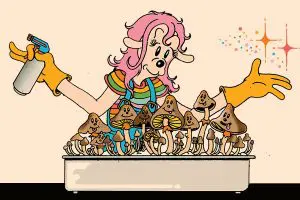Outside the medical world, pain management is likely not the first thing that comes to mind when you hear the word ketamine. If you asked most people about ketamine, they might tell you about the cocaine-white, powdered version of a drug that’s snorted at raves and house parties, making your limbs go heavy and the world feel tilted. Take just one bump too many and you may plunge into a temporary paralysis known as a “K-hole.” But if you asked Dr. Jeffrey Becker about ketamine, you would hear a very different story. In Becker’s eyes, ketamine isn’t a party drug. It’s an entheogen—a spiritual gateway to the “god-within.” It’s through this kind of transcendence that ketamine could be used as a pain management medication to help prevent a new generation of opioid dependents.
Becker is the chief scientific officer of Bexson Biomedical, a research stage company that’s currently working on a unique, subcutaneous formulation of ketamine that he and his colleagues believe could change the landscape of pain management forever. By making ketamine—instead of opioids—the first-line treatment for post-operative pain, Bexson Biomedical is aiming to put a dent in America’s opioid overdose crisis by intercepting potential cases of addiction at their moment of inception.
But according to Becker, getting ketamine approved as an alternative to opioids for post-operative pain treatment is just the beginning. Once ketamine reaches mainstream status in the pain management market, it could eventually make way for what he considers to be an equally exciting prospect: mainstreaming ketamine as a form of psychedelic psychotherapy.
Once ketamine reaches mainstream status in the pain management market, it could eventually make way for an equally exciting prospect: mainstreaming ketamine as a form of psychedelic psychotherapy.
As anyone who’s fallen into a “K-hole” can tell you, ketamine at high doses produces a dissociative, hallucinatory, psychedelic effect. But given the typical settings in which ketamine is recreationally consumed—EDM concerts, house parties, crowded festivals—paralyzing yourself in a hallucinatory trance isn’t always the experience that one hopes for. There’s a big difference between collapsing onto the couch after taking too much ketamine at a party, and receiving a subcutaneous or intramuscular dose of ketamine, administered by a medical professional in a controlled setting, and in conjunction with psychotherapy. In the medical world, this is known as Ketamine Assisted Psychotherapy (KAP).
While generic ketamine isn’t FDA-approved for uses other than as an anesthetic, doctors are legally allowed to prescribe it for “off-label” uses. This is done when a doctor believes that a drug can help treat their patient for a different condition than it’s technically approved for—a common practice in the United States. (Recently, the FDA approved a component of ketamine called esketamine for treatment-resistant depression, however it’s not the same as generic ketamine, and is considered to be prohibitively expensive).
In recent years, the number of healthcare providers willing to offer ketamine off-label as a form of psychotherapy has been growing, with some clinics popping up that are specifically devoted to this type of therapy. But with widespread pushback from insurance companies and the medical boards that oversee clinics and healthcare providers, it’s been difficult for this type of therapy to reach the mainstream. The fact that these therapies are still considered an off-label use of ketamine only further complicates things. And without more established policies, standards, and procedures around these types of therapies, many of the clinics that do exist lack proper oversight, specialized medical staff, or are poorly run in general.
How to Grow Shrooms Bundle
Take Both of Our Courses and Save $90!
Read: Why You Need to Be Careful About the Ketamine Clinic You Choose
According to Dr. Erica Zelfand, a functional medicine physician with specialized training in psychotherapy, it can be a challenge finding the right combination of specialists to oversee these types of therapies, due to ketamine’s unique combination of anesthetic and psychedelic properties. While many KAP providers are capable anesthesiologists, who are trained in managing untoward or emergent side effects, they lack experience in mental health assessment or mental health crisis management. As a result, Zelfand says that providers of these types of therapies have often found themselves in trouble with their respective medical boards.
Insurance companies’ apprehension to reimburse healthcare providers for ketamine therapies further complicates accessibility to this kind of treatment. “Insurance companies can drop you from their panels or audit you or ask for thousands of dollars back if they decide they don’t like the way you coded something or if they think something you do isn’t ‘evidence based,’” says Zelfand. “As long as generic ketamine is off-label in the treatment of mood disorders, insurance companies will be slow to cover it.“
The difficulties that many face when trying to access ketamine for these types of mental health treatments can be incredibly frustrating for patients and medical professionals alike, such as Becker and Zelfand, who see ketamine as a potentially powerful form of psychological therapy.
“The highest level of frequency that goes on in the brain is called gamma,” says Becker. “It is a moment of consciousness—a meaningful perception that there’s something happening. This is the person realizing they’re a person. If localized gamma might signify that, how amazing is it that ketamine turns the whole brain into almost a gamma singularity?” Becker likens the process that takes place in the brain under properly dosed and administered ketamine as “turning down the ego” and escaping our “consensus consciousness reality” to reach a deeper level of self. This psychedelic aspect of ketamine offers a number of potential therapeutic benefits for treating conditions like depression and addiction, and is one of the reasons Becker considers the drug to be such a worthy alternative to opioids, not to mention a way to get off opioids.
Becker likens the process that takes place in the brain under properly dosed and administered ketamine as “turning down the ego” and escaping our “consensus consciousness reality” to reach a deeper level of self.
For those not yet familiar with psychedelics as a form of substance abuse rehabilitation, putting someone under the spell of ketamine may seem like an odd form of treatment for someone who’s already in the throes of drug addiction—like trying to extinguish a house fire with a flamethrower. But from psilocybin—the psychoactive component in shrooms—to LSD, peyote, ibogaine, and beyond, psychedelics are increasingly considered an effective tool in the drug rehabilitation process. Researchers have been interested in ketamine’s potential as a psychotherapeutic addiction treatment for decades.
In a 2002 study coming out of Russia, researchers from the St. Petersburg Research Center of Addictions and Psychopharmacology published the results of a double-blind, randomized clinical trial that assessed the effects of ketamine psychotherapy on 70 patients with heroin use disorders. The patients in the experimental group were administered a hallucinogenic dose of ketamine, while the patients in the control group were given a much lower, non-psychedelic dose. At the end of the study, the researchers found that the psychedelic-dose of ketamine “produced a significantly greater rate of abstinence in heroin addicts” within the two years following the study. This psychedelic dose of ketamine also resulted in a more significant, and longer lasting reduction in patients’ heroin cravings, and even an improvement in “nonverbal unconscious emotional attitudes.”
More recently, a 2018 systematic review of the literature on ketamine’s potential to treat substance use disorders, this time from the United States, looked at ketamine’s potential to treat alcohol, cocaine, and opioid dependencies. The researchers found that ketamine treatments posed benefits to patients’ cravings, motivations, use rates, and abstinence rates, and recommended that further research be done on ketamine’s potential in combating addiction.
Yet, while widespread misinformation and a lack of understanding around psychedelic therapies has caused the mainstream medical community to fear and avoid “non-ordinary states of consciousness,” says Dr. Gregory Wells, co-clinical investigator and therapist with the Multidisciplinary Association for Psychedelic Studies (MAPS), Becker believes that ketamine is uniquely positioned to one day break through that psychedelic barrier. While ketamine isn’t the only psychedelic that has demonstrated efficacy in the treatment of drug dependency, the difference is that other psychedelics—like LSD, psilocybin, and peyote—are not known anesthetics; ketamine is. In other words, ketamine has the potential to offer both psychological—and physical—relief.
In other words, ketamine has the potential to offer both psychological—and physical—relief.
In terms of pain management, ketamine offers some unique advantages. “We know absolutely that ketamine treats both pain acutely—pain in the moment that it’s occurring—and it also turns down the apparatus that causes pain to get worse over time,” says Becker. “So that’s a very special combination.” In contrast, opioids may actually cause a patient to become more sensitive to pain overtime.
Ketamine’s application toward pain management is supported by the American Society of Regional Anesthesia and Pain Medicine, the American Academy of Pain Medicine, and the American Society of Anesthesiologists 2018 consensus guidelines. The guidelines these organizations have put forth use evidence to favor ketamine as a treatment for acute pain “in a variety of contexts, including as a stand-alone treatment, as an adjunct to opioids, and, to a lesser extent, as an intranasal formulation.” This is part of the reason that, according to the World Health Organization, ketamine is the most widely used anesthetic on Earth. But despite its prevalence in the doctor’s office, ketamine has traditionally been a complicated drug to use in prescription form outside the clinic.
In the clinic, medical practitioners can use an IV to administer ketamine to patients with incredible precision, at low doses. In contrast, the ways you could easily self-administer ketamine in the home, such as in the form of lozenges, are either ineffective due to ketamine’s low bioavailability, or because they deliver too big of a load directly all at once. The other issue with ketamine goes back to the problem that rave-goers and house-partiers experience when using ketamine recreationally: Get the dose just a little bit off, and your experience with the drug will change dramatically. These are issues that Bexson Biomedical is working to solve by developing an insulin pump-like device so patients can self-administer ketamine at home, with precise dosing that can reduce pain without inducing any of the drug’s major psychological effects.
These are issues that Bexson Biomedical is working to solve by developing an insulin pump-like device so patients can self-administer ketamine at home, with precise dosing that can reduce pain without inducing any of the drug’s major psychological effects.
“The pump will allow us to deliver ketamine, and deliver steady-state ketamine, at low doses,” says Becker. “That can only be achieved by IV in the clinic currently.” This pump would also address other concerns in the pain management space, such as the potential for misusing or abusing medications. Since the pump would function electronically, Dr. Becker anticipates that it will be able to prevent users from administering more than one dose within a specific timeframe.
Bexson Biomedical’s goal is for this game-changing delivery method to help ketamine become a mainstream pain management treatment, which could provide a more desirable alternative to opioids. Ketamine’s potential to serve as an opioid alternative is partially owed to that, generally speaking, it wouldn’t produce a physical dependence.
“There is a somewhat high abuse potential for ketamine,” says Wells. “But it does not lead to physical dependence in the same way tobacco, alcohol, heroin, or opioids do. In our treatment clinics, we—myself and my colleagues around the country—don’t see drug seeking behavior in our patients and we don’t see patients abusing ketamine when it is prescribed for at-home use. When used in a supervised, controlled, clinical context, I believe the abuse potential is quite low.”
“When used in a supervised, controlled, clinical context, I believe the abuse potential [for ketamine] is quite low.”
By establishing ketamine as a possible alternative to opioids, Becker hopes to also create a foothold in the market with which to one day help ketamine as a form of psychedelic therapy reach the mainstream. And while there are already a handful of ketamine clinics popping up, they’re still few and far between—causing some patients to go find it rogue on the underground market, says Dr. Zelfand.
“Our product will be ideal for KAP because it will be highly controlled and consistent dosing, with minimal lingering metabolites after treatment that can inflame the bladder or create a lingering body load after treatment,” says Becker, who hopes to launch the at-home ketamine pump as a viable treatment for post-operative pain by 2026.
How to Grow Shrooms Bundle
Take Both of Our Courses and Save $90!
Once Bexson Biomedical is able to collect enough data on safe-use with this pump-product, they can use this data to help parlay KAP into mainstream medicine for mental health applications, but even Becker admits that’s likely 15 years away.
In the meantime, Becker says that his work with ketamine has shown him that, while psychedelic therapies show incredible potential as a psychological treatment, oftentimes improving one’s mental health begins with physical healing. Pain management and addiction medicine are the perfect examples of this.
“I really, truly believe that if the body is in pain, if the receptors in your skin, or if the receptors that are in the dorsal horn of the spinal cord are screaming in pain, it’s very hard to feel good,” says Becker. “And that’s really the primary place that a lot of people need help in a lot of cases.”

DoubleBlind is a trusted resource for news, evidence-based education, and reporting on psychedelics. We work with leading medical professionals, scientific researchers, journalists, mycologists, indigenous stewards, and cultural pioneers. Read about our editorial policy and fact-checking process here.

DoubleBlind Magazine does not encourage or condone any illegal activities, including but not limited to the use of illegal substances. We do not provide mental health, clinical, or medical services. We are not a substitute for medical, psychological, or psychiatric diagnosis, treatment, or advice. If you are in a crisis or if you or any other person may be in danger or experiencing a mental health emergency, immediately call 911 or your local emergency resources. If you are considering suicide, please call 988 to connect with the National Suicide Prevention Lifeline.



